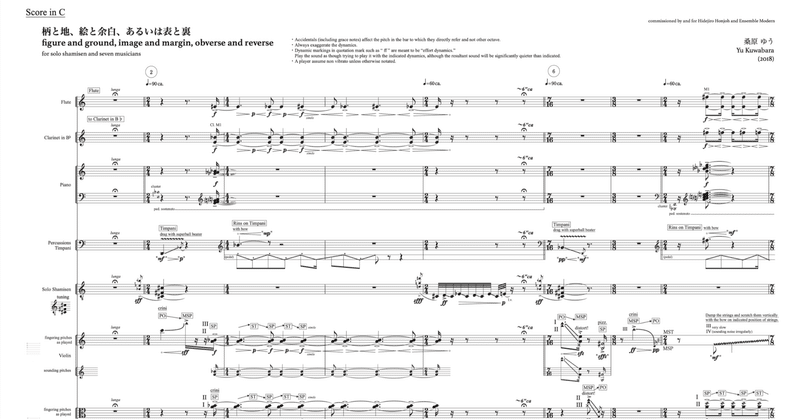
柄と地、絵と余白、あるいは表と裏
作曲年/2018
編成/三味線独奏と7人の奏者 (fl/afl, cl/bcl, perc, pf, vn, va, vc)
演奏時間/約13分
アンサンブル・モデルン(フランクフルト/ドイツ)と本條秀慈郎氏の委嘱による。
English title: figure and ground, image and margin, obverse and reverse
Year of composition: 2018
Instrumentation: solo shamisen and 7 musicians (fl/afl, cl/bcl, perc, pf, vn, va, vc)
Duration: approximately 13 minutes
Commissioned by and for Ensemble Modern and Hidejiro Honjoh
作曲ノート
柄と地、つまり、絵と余白の関係は、時間軸の変化によって転換し、余白が絵を裏側で支えているともいえる。余白が絵を支え、絵が余白を支える、こうした「瞬間の同時」について考えること。物事の境界や隙間に入り込んで「瞬間の同時」を複眼で捉えること。声明作品に携わるなかで、お世話になっている演出家の田村博巳先生から教えていただいた、ものの見方である。
独奏三味線パートを山並みに見立て、アンサンブルパートはその稜線を浮き上がらせる、向こうの空の遠景とする。時間帯によっては、闇と一体化して山容が消え、星の瞬きや家並みの街明かりに惹きつけられる——つまり、アンサンブルの方が優勢となる。柄と地、絵と余白、あるいは表と裏のせめぎ合いをベースに、独奏パートとアンサンブルとの関係性を改めて考察しようと試みたのが、この三味線協奏曲である。
もうひとつ念頭にあったのは、アンサンブルが三味線の音の余韻を彩ったり、増幅したり、三味線のジェスチャーを極端に強調したりする、つまり、アンサンブルを三味線のエフェクターとして用いるような扱い方である。三味線の絃から伝わった空気の振動が、そのままアンサンブルの音として表出するようなイメージを持っている。
《柄と地、絵と余白、あるいは表と裏》は、二〇一八年十月にフランクフルトにて、本條秀慈郎氏の独奏と、馬場武蔵氏の指揮、そして、アンサンブル・モデルンにより世界初演された。二〇一九年七月に開催した「影も溜らず — 淡座リサイタルシリーズVol.1 桑原ゆう個展」で、日本初演と相成った。
Composer's note
The relationship between an image and a margin shifts with the transition of time. If you see it from a different perspective, a margin can be said to support the image on the backside.
Think about these "simultaneous moments" where a margin supports an image, and an image supports a margin. Penetrating the boundaries and gaps of things and capturing the "simultaneous moments" with multiple eyes. I learned how to look at things from the director Hiromi Tamura while working on Shomyo pieces.
The solo shamisen part is regarded as a mountain range. The ensemble part becomes a distant view of the sky beyond, showing the mountain range in relief. Depending on the time, the mountains disappear into the sky and become one with the darkness. Then, our eyes get attracted to the twinkling stars and the city lights of the houses…; in other words, the ensemble will have the upper hand. In this Shamisen Concerto, I attempted to re-examine the relationship between a solo part and an ensemble based on the interplay between figure and ground, image and margin, or obverse and reverse.
Another idea in my mind was that the ensemble would color or amplify the lingering sound of the shamisen or emphasize the shamisen's musical gestures. Therefore, the ensemble was treated as if it were the effector of the shamisen. The vibrations transmitted to the air from the shamisen strings would be interpreted directly as the ensemble's sound.
日本の作曲 2010-2019(サントリー芸術財団出版)に選評
(p84-85に批評掲載)
www.suntory.co.jp/sfa/music/publication/pdf/composition2010-2019.pdf
Audio Release
Recording (excerpt)
Performance history
(As of 17 August 2022)
10 October 2018 - world premiere
Checkpoint Hidejiro Honjoh
Dachsaal, Haus der Deutschen Ensemble Akademie, Schwedlerstraße 2, 60314 Frankfurt am Main, Germany
Hidejiro Honjoh, solo shamisen
Musashi Baba, conductor|Ensemble Modern
www.ensemble-modern.com/en/news/2018-09-24/checkpoint
www.deutsche-bank-stiftung.de/10-10-2018-ensemble-modern-meets-honjoh-hidejiro/
2019年7月13日 - 部分的に演奏
桑原ゆう個展プレイベント — 自作語りとミニライブ
@JBSトレーニングセンター(東京都港区西新橋2-3-1マークライト虎ノ門9F)
演奏/淡座[三瀬俊吾(ヴァイオリン)、竹本聖子(チェロ)、本條秀慈郎(三味線)]
2019年7月13日 - 日本初演
影も溜らず — 淡座リサイタルシリーズVol.1 桑原ゆう個展
@東京オペラシティ リサイタルホール(東京都新宿区西新宿3-20-2 東京オペラシティタワーB1F)
演奏/本條秀慈郎(三味線独奏)、水戸博之(指揮)、梶川真歩(フルート)、西村薫(クラリネット)、中山航介(打楽器)、大須賀かおり(ピアノ)、三瀬俊吾(ヴァイオリン)、笠川恵(ヴィオラ)、竹本聖子(チェロ)
この記事が気に入ったらサポートをしてみませんか?
